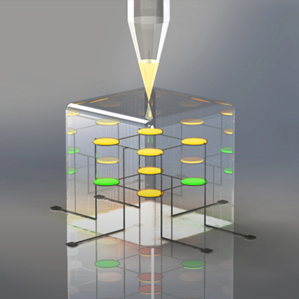3-D-Printing Bio-Electronic Parts
A 3-D printer can already make a prototype or spare part out of metal or polymer. Researchers at Princeton University have now taken an important step toward expanding the technology’s potential by developing a way to print functioning electronic circuitry out of semiconductors and other materials. They are also refining ways to combine electronics with biocompatible materials and even living tissue, which could pave the way for exotic new implants.

With cartridges full of semiconductor “inks,” it should be possible to print circuits for all sorts of tasks, says Michael McAlpine, an assistant professor at Princeton, who led the work. To demonstrate the feat, the researchers printed a light-emitting diode within a contact lens.
The processors and display circuitry inside a computer don’t lend themselves to 3-D printing, because they require many complex components fabricated on the nanoscale. But it could be used to make medical devices or implants that incorporate electronics. Researchers might, for example, print a scaffold for growing nerve tissues, says McAlpine. And if they could also print LEDs and circuits within the scaffold, the light could stimulate the nerves, and the electronics could be used to interface with a prosthetic arm, he suggests.
Last year, McAlpine used 3-D-printing to make a “bio-electronic” ear (see “Cyborg Parts”). The ear was made from living cells, with a supportive matrix of gooey hydrogel; it also had conductive ink, made from a suspension of silver nanoparticles, which formed an electrical coil that could receive radio signals.

Since then, McAlpine’s group has been working to expand 3-D printing to semiconducting materials that would allow a printed device to process incoming sounds. Semiconductors are a key ingredient of information-processing circuits and can also be used to detect and emit light.
To broaden the 3-D-printing palette, McAlpine’s group built its own printer; most of the ones on the market today are only designed to print plastic. “If you try to put other stuff in it, it will jam,” he says. They also needed to be able to print at a higher resolution. The bionic ear, for instance, had features on the millimeter scale—and to make LEDs they had to go to the micrometer sale.
To make the LED, the Princeton researchers chose quantum dots—semiconducting nanoparticles that emit very bright light in response to electrical current. They also used two kinds of metal to make electrical leads and contacts for the devices, as well as polymers and a silicone matrix to hold it all together. One challenge when printing with so many inks is the risk that they will bleed into each other. So the researchers had to make sure to suspend each material in a solvent that would not mix with any of the others.
McAlpine’s group made a cube of eight green and orange LEDs stacked two by two by two. The researchers printed the LEDs on a contact lens after scanning it to make the shape of the printed devices match the curvature of the lens surface.
“The LED is just part of the puzzle of 3-D-printing active electronics,” says McAlpine. Once researchers can print active electronic materials, they should be able to make information-processing circuits, sensors, light detectors, and other elements—and integrate them with biological tissues, he says.
McAlpine and his colleagues are not the only ones rapidly expanding the possibilities of 3-D printing. “Most 3-D printing is like a glorified hot-glue gun, just printing polymers,” says Michael Dickey, a chemical engineer at the North Carolina State University in Raleigh, who was not involved with McAlpine’s work. But his group has developed a liquid metal that can be printed into stretchable, self-healing wires (video here). And Jennifer Lewis, a professor of biologically inspired engineering at Harvard, has been developing 3-D printing for tissue engineering by combining multiple cell types in complex patterns that include blood vessels.
McAlpine is using the new technique to make customized biomedical devices, some of which are being tested in animal studies. He declines to share the details of this unpublished work, but he adds that he’s also started making complex electronic devices using living cells.
Keep Reading
Most Popular
Large language models can do jaw-dropping things. But nobody knows exactly why.
And that's a problem. Figuring it out is one of the biggest scientific puzzles of our time and a crucial step towards controlling more powerful future models.
The problem with plug-in hybrids? Their drivers.
Plug-in hybrids are often sold as a transition to EVs, but new data from Europe shows we’re still underestimating the emissions they produce.
Google DeepMind’s new generative model makes Super Mario–like games from scratch
Genie learns how to control games by watching hours and hours of video. It could help train next-gen robots too.
How scientists traced a mysterious covid case back to six toilets
When wastewater surveillance turns into a hunt for a single infected individual, the ethics get tricky.
Stay connected
Get the latest updates from
MIT Technology Review
Discover special offers, top stories, upcoming events, and more.